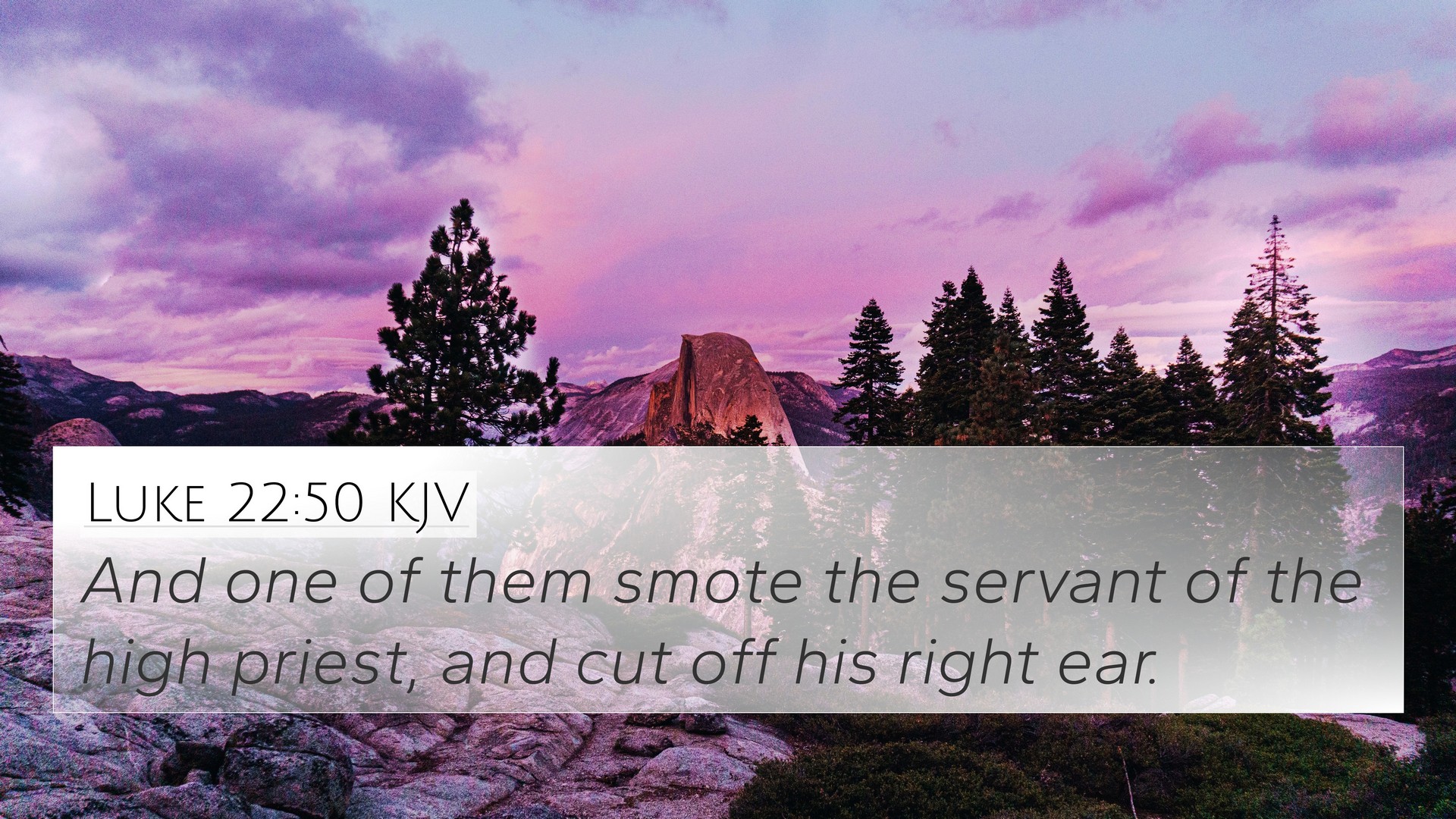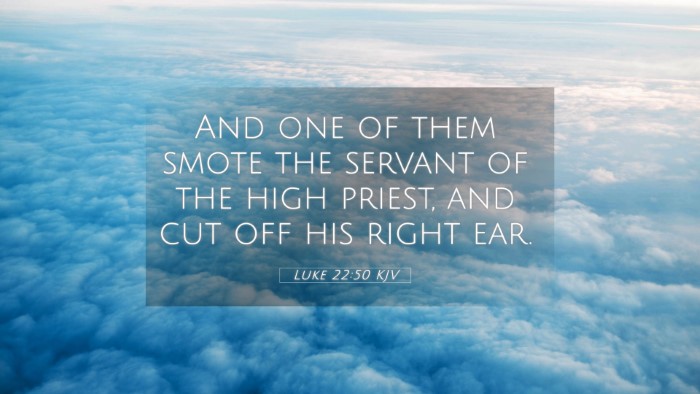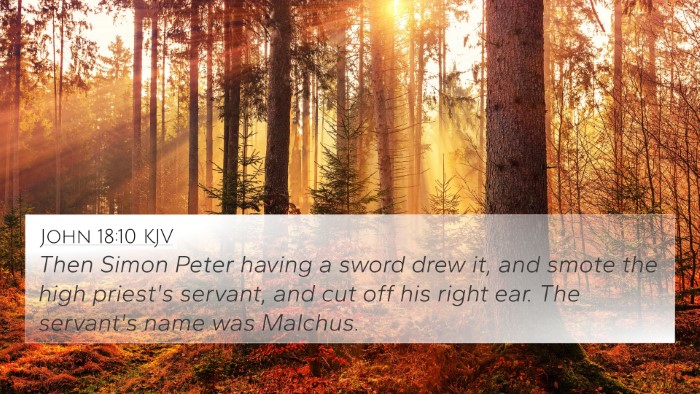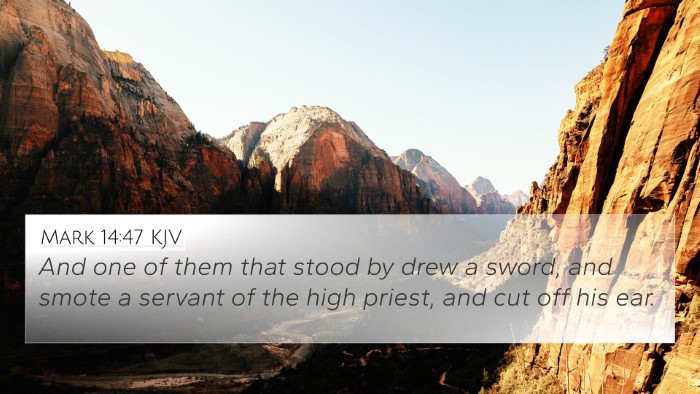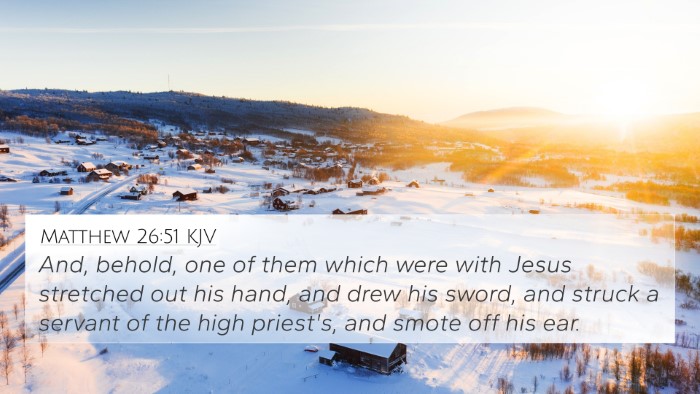Understanding Luke 22:50
Luke 22:50 states: "And one of them smote the servant of the high priest, and cut off his right ear."
This moment occurs during the arrest of Jesus in the Garden of Gethsemane, where the tension and chaos escalate as one of Jesus' followers reacts in defense of his master. To grasp the full significance of this event, we can examine insights from various public domain commentaries.
Overview of Luke 22:50
In this verse, the act of cutting off the servant's ear symbolizes the human instinct for violence in the face of perceived threat. This incident not only highlights the emotional turmoil surrounding Jesus at this moment but also serves as a pivotal moment in the narrative leading up to His crucifixion.
Commentary Insights
- Matthew Henry's Commentary: Henry emphasizes the impulsive nature of the disciple's action, viewing it as a manifestation of human frailty and fear. He points out that this incident is a stark contrast to the teachings of Jesus, who preached love and non-violence. This act of aggression foreshadows the misunderstandings that would plague Jesus' followers even after His resurrection.
- Albert Barnes' Notes: Barnes highlights the identity of the attacker as Peter, demonstrating how even the closest disciples can falter under pressure. He notes that this assault was not just a defense of Jesus but also reflects a lack of understanding of His mission. Barnes discusses how Jesus later heals the servant's ear (as seen in Luke 22:51), showcasing His response of compassion amidst violence.
- Adam Clarke's Commentary: Clarke suggests that the act of cutting off the ear was both impulsive and misguided. He points out that it showed a lack of faith in Jesus’ power. Clarke also notes that the incident is important for its implications about the nature of Christ's kingdom, which does not advance through violence but through suffering and sacrifice.
Related Bible Cross-References
- Matthew 26:51-54: This passage parallels the account in Luke, detailing Peter's act and Jesus’ rebuke of the violence.
- John 18:10-11: This scripture specifically identifies Peter as the one who struck the high priest's servant and further emphasizes Jesus' call to non-violence.
- Isaiah 53:5: This verse speaks to the suffering servant concept, which finds its fulfillment in Jesus’ actions during His arrest.
- Luke 6:29: Here, Jesus teaches about turning the other cheek, contrasting with Peter's violent reaction.
- Romans 12:21: Paul advises believers not to be overcome by evil, but to overcome evil with good, reflecting Jesus' non-violent response in the garden.
- 1 Peter 2:21-23: Peter later reflects on Jesus’ willingness to suffer without retaliation, which contrasts his earlier impulsiveness.
- Exodus 21:24: The principle of “an eye for an eye” is referenced to explain the societal norms of retribution that Jesus seeks to overturn.
- Lamentations 3:30: This verse advises turning the cheek to the smiter, highlighting the theme of suffering without retaliation.
- Matthew 5:39: Jesus’ Sermon on the Mount includes teachings against resistance to evil, further emphasizing His kingdom’s ethos.
- Hebrews 12:2: This verse encourages believers to look to Jesus, who endured suffering without retaliation, connecting His actions to the broader narrative of redemption.
Comprehensive Study and Analysis
For those studying Luke 22:50, it is crucial to consider the implications of violence in the Christian life. This verse serves as an important reminder of the turmoil and misunderstandings that can arise among believers, emphasizing the need for grace and understanding. Cross-referencing related verses can yield deeper insights into the themes of violence, redemption, and divine compassion present in the crucifixion narrative.
By exploring the connections between biblical texts, students and scholars can engage in comparative Bible verse analysis that enhances their understanding of scriptural themes. Using tools for Bible cross-referencing, one can uncover rich inter-Biblical dialogues that inform contemporary Christian practice and theology.
Conclusion
Luke 22:50 not only captures a moment of impulsive reaction but also provides a profound insight into the nature of Christ’s kingdom. Understanding this verse in the context of other biblical passages fosters greater appreciation for the overarching narrative of Scripture. This encourages believers to seek peace and understanding, even when faced with conflict, aligning with Jesus’ teachings of love and reconciliation.
Further Reflections
As readers reflect on this verse, consider the broader implications for personal faith and community relations. What does this teach about how we react to adversity? How can cross-referencing enhance our understanding of such critical moments in Jesus’ life? Engaging with the text and related scriptures provides a pathway to navigate these theological concerns with clarity and purpose.
